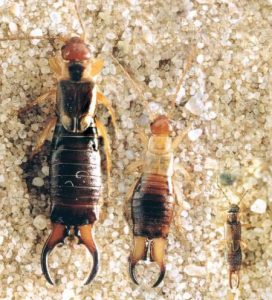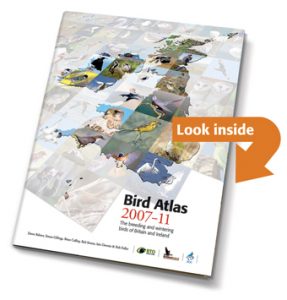Dr Eugenie Regan from the National Biodiversity Data Centre introduces us to Ireland’s three species of earwig.

Earwigs are an unloved group of insects. They generate reactions of disgust from the general public, are considered by most a pest, and are surely one of the reasons that insects have a bad name.
But they are also a fascinating animal. For example, did you know that earwigs display maternal care? A characteristic that is uncommon amongst the other 12,000 insect species in Ireland, who tend to abandon their young without any apparent concern. Not earwigs! Female earwigs care for their eggs and watch over their offspring after they have hatched as nymphs. This characteristic has fascinated and baffled scientists because insects rarely display such caring behaviour.
The common term, earwig, is derived from the Old English ēare, which means ear, and wicga, which means insect. The name may be related to the old wives’ tale that earwigs burrowed into the brains of humans through the ear and laid their eggs there. A strange tale which hasn’t done much for their PR! Indeed although ears are not their natural habitat, earwigs are predisposed to hiding in warm humid crevices and may occasionally crawl into the human ear canal (much like any other small organism).
Three species of these fascinating animals occur in Ireland. That’s a very small number compared to other insect groups, and is an advantage when trying to identify to species level. One difficulty with identifying earwigs is that the young look very like adults, but only the adults can be distinguished to species level. Luckily for us, two of our three species are very rare in Ireland.
 The Common Earwig as the name suggests is common and widespread in Ireland. It should theoretically occur in every 10km square but the National Biodiversity Data Centre has very few records for this animal.
The Common Earwig as the name suggests is common and widespread in Ireland. It should theoretically occur in every 10km square but the National Biodiversity Data Centre has very few records for this animal.
The Lesser Earwig is a very small animal and easily confused with the young of the Common Earwig. It’s most easily distinguished by habitat as it only occurs in warm, moist dung heaps! Horse dung being a favourite! There are scattered records for this animal in the southern half of Ireland.
Lesne’s Earwig looks very similar to the Common Earwig and is perhaps overlooked in Ireland. To distinguish between the two species you need to look for wings protruding from under the thorax – these are present in the Common Earwig and the Lesser Earwig but not in Lesne’s Earwig. You’re only likely to encounter this species, however, if you live on the Waterford coast.
So if you are not looking in warm, moist dung heaps or live anywhere other than Waterford, you’ll only see the Common Earwig. Instead of reacting with disgust, committing pre-meditated murder, or running away when you next encounter an earwig, please take a moment to appreciate the unusual caring character of this insect and submit your earwig sighting to the National Biodiversity Data Centre. Every record we receive helps add to our understanding of the distribution of this fascinating animal in Ireland.










10 comments
Carl
Just encountered and earwig
Crawling across our kitchen floor
Went under the skirting and that was that
My partner screamed when she saw it, but I said let it be
Not sure why, but I don’t mind earwigs, or woodlice- as long as there isn’t an infestation of them, i leave them be
Carl
Banna east
Ardfert
Co kerry
Fiona Walshe
Our home is full of earwigs, every night I come across them when I turn on a light, racing across the floor. I have small children and am looking to get rid of them from our home. Any advice?
Eileen Pugh
The common earwigs have infested our garden. Eating leaves, blooms and destroying many plants. Sunflowers chrysanthemum busy lizzie dahlia Japanese anemone roses agapanthus geranium etc. Shocked by the numbers visible by torch at night!! They have caused more damage in last 6 weeks
than 30 seasons of slugs!
Rory P Cunningham
Never knew there were three types. Never knew they had wings and could fly. After reading this page, I now regret Killing one in the house today. It was big so I feel sure it was the common. Location Ardara Co Donegal. Thank you for the great information. Yes it is amazing how its the only Irish insect to care for its young……Thank you
Tom Curtis
Hi, i have an allotment in south DUBLIN so i get to see lots of earwigs eall the time, i dont think they are a threat to anything i grow so i really just ignore them, would’nt dream of harming them in any way but i did’nt know there were several different species i just thought the smaller ones were younger!, i will take a bigger interest in them from now on, thanks for your info
Cheers
ed staunton
Hi Eugenie, am one of your former Heritage students, enjoyed finding your piece on earwigs, weird how ive always harboured an affection for earwigs, it makes no sense to look at them! Must be some inate humam trait to be identify non dangerous insects. Unloved no more!
lorraine kelly
i keep finding earwigs in the clothes i bring in from the clothesline, which is ok, they just give me a fright, however just a few moments ago, when i shook one out of a piece of clothing, it fell on the floor and crawled into the path of a spider, i saw it use its pincers to fend off the spider and crawl under the skirting board, fascinating to watch!
Bill Hunter
Strangely enough, I never looked at the possibility there is more than one species.
Now, where’s that dung heap…
Calvin Jones
Hadn’t been checking dung heaps myself either Bill. Will have to pay more attention.
Cat Holland
I thought they were called EARwigs because their wings are shaped like an ear.